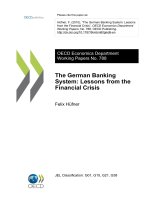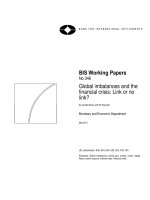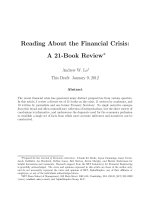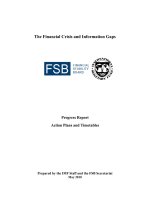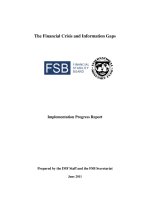kolb - the financial crisis of our time (2011)
Bạn đang xem bản rút gọn của tài liệu. Xem và tải ngay bản đầy đủ của tài liệu tại đây (3.37 MB, 425 trang )
The Financial Crisis of Our Time
FINANCIAL MANAGEMENT ASSOCIATION
Survey and Synthesis Series
Beyond Greed and Fear: Understanding Behavioral Finance and the Psychology
of Investing
Hersh Shefrin
Value Based Management: The Corporate Response to Shareholder Revolution
John D. Martin and J. William Petty
Debt Management: A Practitioner’s Guide
John D. Finnerty and Douglas R. Emery
Real Estate Investment Trusts: Structure, Performance, and Investment
Opportunities
Su Han Chan, John Erickson, and Ko Wang
Trading and Exchanges: Market Microstructure for Practitioners
Larry Harris
Valuing the Closely Held Firm
Michael S. Long and Thomas A. Bryant
Last Rights: Liquidating a Company
Dr. Ben S. Branch, Hugh M. Ray, Robin Russell
Efficient Asset Management: A Practical Guide to Stock Portfolio Optimization
and Asset Allocation, Second Edition
Richard O. Michaud and Robert O. Michaud
Real Options in Theory and Practice
Graeme Guthrie
Slapped by the Invisible Hand: The Panic of 2007
Gary B. Gorton
Asset Pricing and Portfolio Choice Theory
Kerry E. Back
The Financial Crisis of Our Time
Robert W. Kolb
The Financial Crisis
of Our Time
2011
ROBERT W. KOLB
1
Oxford University Press, Inc., publishes works that further
Oxford University’s objective of excellence
in research, scholarship, and education.
Oxford New York
Auckland Cape Town Dar es Salaam Hong Kong Karachi
Kuala Lumpur Madrid Melbourne Mexico City Nairobi
New Delhi Shanghai Taipei Toronto
With offices in
Argentina Austria Brazil Chile Czech Republic France Greece
Guatemala Hungary Italy Japan Poland Portugal Singapore
South Korea Switzerland Thailand Turkey Ukraine Vietnam
Copyright © 2011 by Oxford University Press, Inc.
Published by Oxford University Press, Inc.
198 Madison Avenue, New York, New York 10016
www.oup.com
Oxford is a registered trademark of Oxford University Press
All rights reserved. No part of this publication may be reproduced,
stored in a retrieval system, or transmitted, in any form or by any means,
electronic, mechanical, photocopying, recording, or otherwise,
without the prior permission of Oxford University Press.
Library of Congress Cataloging-in-Publication Data
Kolb, Robert W., 1949–
The financial crisis of our time / Robert W. Kolb.
p. cm.
Includes bibliographical references and index.
ISBN 978-0-19-973055-1 (cloth : alk. paper) 1. Financial crises—United States—History—20th
century. 2. Financial crises—United States—History—21st century. I. Title.
HB3743.K58 2011
330.973—dc22
2010015648
9 8 7 6 5 4 3 2 1
Printed in the United States of America
on acid-free paper
3
CONTENTS
Preface ix
Abbreviations xxi
1 Introduction: The Financial Crisis of Our Time 1
Before the Great Depression 2
From the Great Depression to Financial Deregulation 4
From Financial Deregulation to the Savings and Loan Crisis 10
2 From Securitization to Subprime 16
The Development of Securitization 16
The Process of Securitization: An Overview 26
Credit Enhancement 33
The Subprime Difference 35
3 Before the Deluge 38
Subprime Lending: To the Peak 38
The Height of Subprime Lending 46
4 From the Subprime Crisis to Financial Disaster: An Overview 57
The Housing Peak to Hints of Something Wrong 57
vi CONTENTS
The Slide Accelerates 59
Mortgage-Backed Securities and Foreclosures 61
No Relief in 2008 63
The Climax? 67
Back from the Brink 72
5 Extinctions 74
Among the Ruins 74
From Countrywide to IndyMac 75
IndyMac 77
Washington Mutual 80
Wachovia 82
Bank Extinctions, Banking Consolidation, and Too-Big-to-Fail 84
6 The End of Investment Banking 87
Big Brains, Big Egos, and Big Pay 87
Bear Stearns 88
The Bankruptcy of Lehman Brothers 96
Merrill Lynch: The Herd Goes to the Abattoir 98
Goldman Sachs, Morgan Stanley, and the Week That Remade
Wall Street 102
7
When Zombies Walk the Earth 109
Fannie Mae and Freddie Mac 110
AIG 117
Citigroup: The Biggest Zombie of Them All 124
Zombies and the Future 126
8 Policy Responses and the Beginnings of Recovery 128
Unfurling the TARP 129
The Market Reacts 131
The TARP Evolves 133
Introduction of the TALF 136
Instituting More Programs 138
Support for the Auto Industry 138
Support for Home Owners 139
Green Shoots in the Financial Sector 139
Initial Cost Assessment 140
viiContents
9 Causes of the Financial Crisis: Macroeconomic Developments
and Federal Policy 143
The Basic Story 144
Macroeconomic Developments 146
Federal Stimulative Policy and Legislation 148
Attempts to Combat Mortgage Lending Discrimination and to
Expand Home Ownership to Minorities 149
National Homeownership Strategy 151
The Causal Role of the GSEs 155
10 Causes of the Financial Crisis: The Failure of Prudential Regulation 160
Regulation of Depository Institutions 162
Regulation of Lines of Business 162
Capital Requirements 163
Interaction Between Capital Regulation and Credit Derivatives 166
Regulation of Size and Scope—“Too Big to Fail” 167
Restrictions on Concentration of Risk 169
Regulation of Securities Markets and Supporting Institutions 170
Capital Regulations 170
Off-Balance Sheet Corporate Entities 173
Credit-Rating Agencies 174
Mark-to-Market Accounting Rules 178
Complex Financial Derivatives 181
The Regulation of AIG 181
Poor Regulation of Mortgage Industry 183
Emergency Responses to the Crisis and “Really Too Big to Fail” 184
Defects in Regulatory Architecture 186
11 Causes of the Financial Crisis: From Aspiring Home Owner
to Mortgage Lender 187
The Borrower 190
The Lender 191
The Appraiser 195
The Mortgage Broker 197
The Mortgage Frenzy, the Originator, and Underwriting Standards 203
12 Causes of the Financial Crisis: From Securitizer to Ultimate Investor 208
Purchasing Mortgages 209
Creating Securities and Obtaining Ratings 211
viii CONTENTS
To the Ultimate Investor 221
Incentives from Securitizers to Ultimate Investors 224
13 Causes of the Financial Crisis: Financial Innovation, Poor Risk Manage-
ment, and Excessive Leverage 226
Financial Innovation and the Creation of Complex Instruments 227
Poor Risk Management 232
Excessive Leverage 236
14 Causes of the Financial Crisis: Executive Compensation and Poor
Corporate Governance 239
Pay at Financial Firms 241
Risk-Taking and Executive Compensation in the Financial Crisis 249
Incentives, Risk-Taking, and Compensation at Fannie Mae 250
Executive Compensation at Lehman Brothers 253
Incentive Confl icts 256
Corporate Governance in the Financial Crisis 257
15 Consequences of the Financial Crisis and the Future It Leaves Us 260
Measuring the Damage: A Warning 260
The Bailout and Its Costs 261
From 2006 to 2009: Our Economic World and How It Has Changed 266
Reduced Circumstances: Our Economic Future 268
Beyond the Merely Economic—American Recessional or American
Renewal? 272
Perfecting the Fatally Flawed Regulatory Regimes of the Past 275
The Financial Crisis, the Great Recession, and Institutional Failures 277
Fundamental Reform? 281
“Too Big to Fail” 282
Corporate Governance, Executive Compensation, and Firms’
Risk-Taking 284
Conclusion: Dopes, Genius, Saints, Scoundrels, and Ordinary
People 286
Glossary 289
Appendix A: Timeline of the Subprime Financial Crisis 301
Appendix B: The Original TARP Proposal: Legislative Proposal for
Treasury Authority To Purchase Mortgage-Related Assets 317
Notes 321
References 357
Index 379
ix
PREFACE
The economic crisis that began in 2007 has changed the economic lives
of Americans and many people around the world. By any measure, this
financial crisis of our time is one of the most important economic events
of the last century, and compared to all other economic and financial
upsets since the Great Depression, it is surely the most significant. Like
the Great Depression itself, these current financial problems, already
dubbed the Great Recession, are proving to have profound social signif-
icance as well.
There are already many signs that the economic and social derange-
ments caused by the crisis have affected the way that people think about
their economic lives, their living habits, and their fundamental values.
For example, we Americans have been notorious for our high consump-
tion and low savings rate. Yet that behavior seems to have changed in
just a few months. Contrary to our former love of conspicuous con-
sumption, newspapers feature the joy of frugality that many of our
fellow citizens claim to have discovered. Whether such new habits will
persist will be revealed in time, and for the present these accounts may
certainly occasion skepticism. However, such uncertainty about the
meaning of the interesting times in which we live is characteristic of all
evolving social phenomena of any significance. On any understanding,
x PREFACE
the events through which we are now living are sure to have profound
importance.
Millions of individuals have lost very substantial portions of their
wealth. With broad U.S. stock market measures having declined a full 50
percent from their recent peaks, the losses have touched almost every-
one. While the markets have rebounded considerably from their low in
March 2009, they are far from a full recovery. Further, the collapse of
stock market values scared many from the markets altogether, so they
failed to participate in the partial rebound that has occurred. As a result,
many Americans, as well as many abroad, are changing their life plans
and postponing their long-anticipated retirements.
Additionally, there is the prospect that these shattering financial
events may change attitudes toward risk-taking. The United States has
long been a vital source of the world’s innovation and entrepreneurship,
and increasing fear of risk may cause that source of wealth creation and
human betterment to falter. The lives of those who lived through the
Great Depression were often transformed by that experience, with a
resulting focus on saving and financial conservatism, along with a gen-
eral fear of risk. By contrast, the children of the Great Depression’s gen-
eration have generally exhibited a striking confidence and optimism
about the future. Presently there are many signs that this positive atti-
tude toward investment and the future may be lost. These signs of vast
psychological adjustment may prove to be merely temporary, or they
may be profound and enduring.
Today the role of business and commerce in our society is under
revision and a renewed attack. Vociferous protests rage against high
levels of compensation. Many think that the unbridled pursuit of profit
led to the economic crisis with its resulting enormous adverse effects
on the real economy. Factory workers who have lost their jobs see a
causal connection leading directly from a greedy pursuit of profits,
high levels of compensation, and flagrant risk-taking, on the one hand,
to their own very real financial difficulties, on the other. Each new
round of business distress brings with it an increase in government
scrutiny and a new wave of regulation. This was certainly true after the
corporate scandals of the early 2000s, and all of the signs today suggest
that there will certainly be more vigorous regulation of financial firms,
including their compensation of executives. Further, it seems that this
crisis may provide an important impetus for global cooperation in reg-
ulation, a movement that was already in progress before the present
difficulties.
xiPreface
The current financial crisis is a social phenomenon of a kind similar
to the Great Depression, the Enclosure Movement in England of the
nineteenth century, or the economic awakening of China in our own
day. While our financial crisis is unlikely to be of the same magnitude, it
is nonetheless a development that alters the lives of millions. Like these
and many other social events or movements that change the lives and
perceptions of millions of people, the financial crisis of our age will be
the subject of study and debate for decades. The public at large, profes-
sional economists, policy experts, public intellectuals, and the citizenry
are all struggling to understand the crisis that has washed over us.
Everyone has an interest in understanding its meaning for our lives, and
many efforts have already sprung up to attempt to identify the causes of
the crisis.
To some extent, it has become a sport to identify the cause of the
financial crisis. Various single-cause explanations focus alternatively on
personal and corporate greed, global imbalances between suppliers and
demanders of investment funds, excessive liquidity in the financial
system, low interest rates and weak monetary policy at the Federal
Reserve, poor lending practices at financial institutions, predatory
lending by rapacious financial institutions, mortgage fraud by housing
speculators, too little regulation, too much regulation, or a faulty process
of generating new securities. Ultimately, few people believe that any
single one of these causes can account for the entire disaster, and many
fall back on the metaphor of a “perfect storm” to emphasize that many
factors operated together to generate the financial crisis. In contrast to
those who seek to emphasize a single cause of the current crisis, this
book moves from a broad study of the economic history of our times to
focus on several decisive changes. In addition to exploring the causes of
the current crisis, the book provides the reader with a comprehensive
review of the context within which these events unfolded.
This book argues that no single such cause can be identified. At the
same time, however, virtually all analysts agree that housing finance
played a central role in the events that have come to dominate our lives.
For example, those who focus on excessive liquidity as a primary cause
of the crisis typically also note that the resulting loose cash was directed
toward housing and helped to inflate the pricing of residential real
estate. While realizing that no giant social phenomenon can have a
single cause, this book also argues that the events of 2006–2009 cannot
be understood without comprehending the mechanism by which the
housing industry came into crisis. Those events essentially began in
xii PREFACE
2006 as residential real estate prices peaked and then started to fall,
threatened the world’s largest and most respected financial institutions
beginning in 2007, and confronted the real economy with serious prob-
lems and even disaster in 2008, leading to profound unemployment that
persisted through 2009 and well into 2010. In briefest terms, this book
offers part of the answer to the big question: “Why would millions of
dopes, geniuses, saints, scoundrels, and ordinary people all work to-
gether to lose trillions of dollars?”
Whatever one chooses as a favorite candidate for the cause of the
crisis, this book further argues that any account must consider the
housing finance system as it developed throughout the twentieth cen-
tury, and especially in the period from 1990 to 2006. The account must
also examine the participants in the new industrial organization of
housing finance. As the book will show, the movement from an origi-
nate-to-hold to an originate-to-distribute model of mortgage financing
confronted market participants with an entirely new array of incentives
that proved to be a “clockwork of perverse incentives.” That is, the per-
verse incentives of all of the participants in the new world of mortgage
finance—including borrowers, mortgage brokers, appraisers, loan orig-
inators, securitizers, due diligence firms, rating agencies, ultimate inves-
tors, legislators, and bureaucrats—fit together in a manner that
constituted an intricate mechanism or clockwork. The unique feature of
this system was that the various participants, simply by responding in-
dividually to the incentives that lay before them and pursuing their
narrow personal interests, participated in an elaborate mechanism that
led to disaster. Unlike clockwork, however, there was no overall archi-
tect or designer for the system of housing finance that led to ruin.
Instead, the system was an unhappy organic production of many indi-
viduals, groups, and forces.
After briefly discussing the industrial organization of housing
finance and the older originate-to-hold model, which will serve as a con-
trast, the book proceeds to a narrative of the crisis as it developed and
continues by analyzing the participants in the originate-to-distribute
model, starting with the home buyer and ranging through to the ulti-
mate investors in CDOs—collateralized debt obligations. At each step,
and as shown in the table of contents, the book explains in a nontechnical
manner the essential relationships among the market participants and
zeroes in on the incentives facing each party. Thus, one primary contri-
bution of the text is to analyze the incentives facing all the actors in the
originate-to-distribute mortgage cycle, because only by understanding
xiiiPreface
the incentives that various parties confronted can we understand their
behavior and its ultimate effect.
The book is organized as follows. Chapter 1, Introduction, reviews
the structure of U.S. residential real estate markets as it developed in the
twentieth century and discusses its economic and regulatory features. In
doing so, this chapter provides the necessary background for under-
standing the financial and regulatory innovations that played such a
central role in the current crisis. For example, the chapter examines the
growth in the rate of home ownership and the economic changes and
government policy that stimulated that growth. As later chapters will
reveal, the push for ever more widespread home ownership had its own
important role to play in generating the crisis.
Chapter 2, From Securitization to Subprime , discusses two models of
industrial organization for the mortgage market. Following World War
II and lasting until the late twentieth century, the U.S. mortgage market
followed an originate-to-hold model of mortgage production. In briefest
terms, a prospective home buyer applied to a local financial institution,
typically a savings and loan association (S&L). If the loan was granted,
the S&L then held that mortgage in its own portfolio for the full life of
the mortgage, which was typically 30 years. While this model worked
quite well in many respects, technical aspects of the model eventually
came to be seen as retarding growth in home ownership. With public
policy directed toward stimulating home ownership, the originate-to-
hold model was eventually supplanted by the originate-to-distribute
model. Under this approach, the initial lender (such as the S&L in the
originate-to-hold model) would initiate a mortgage loan and then im-
mediately sell that loan to another financial institution, and the home-
owner’s payments on the mortgage would be used as the financial basis
for that purchaser to issue new securities. This is the process of securiti-
zation —using the cash flows from one set of securities as the financial
basis to issue a completely new second set of securities with quite dif-
ferent characteristics, a process explained in chapter 2. Chapter 2 also
explains the reasons for the transition from the originate-to-hold to the
originate-to-distribute model and briefly explains the elements of the
more complicated originate-to-distribute model, especially the critical
role of securitization.
Chapter 3, Before the Deluge , considers the false paradise that pre-
ceded the financial crisis. In that apparently happy state, ours was a
world of expanding home ownership, low interest rates, readily avail-
able credit, and escalating home prices. Much of this comforting illusion
xiv PREFACE
was driven by subprime lending, and this chapter chronicles the rise of
subprime up to the peak of housing prices that occurred at about the end
of 2006. We all now know that this world of illusion was merely the pre-
lude to disaster.
Chapter 4, From the Subprime Crisis to Financial Disaster: An Over-
view , quickly surveys the development of the crisis, starting from the
housing peak. The chapter provides a synoptic view of the buildup
to the crisis, considers the architecture of the governmental response
to the crisis, and takes the narrative up to the point at which the
threat to the entire economy began to diminish. All of the themes
introduced in this chapter are explored in more detail in the chapters
that follow.
Chapters 5 through 8 focus on individual major firms that played
prominent roles in the crisis. Chapter 5, Extinctions , turns the spotlight
on major depository institutions that disappeared from the scene
through outright failure or acquisition. Countrywide Financial, perhaps
the most notorious of giant subprime lenders, was absorbed by Bank of
America. In one of the largest bankruptcies in history, the Federal De-
posit Insurance Corporation (FDIC) seized IndyMac, which had been
spawned by Countrywide. In a deal brokered by the FDIC, JP Morgan
Chase (often referred to in this book and elsewhere as just “JPMorgan”)
acquired the huge Washington Mutual, another subprime lender that
rivaled Countrywide in size and scope. Citigroup, itself among the
walking wounded, reached an agreement to take over Wachovia Na-
tional Bank, based on promised assistance from the FDIC. At the last
minute, Wells Fargo entered the scene and wrested Wachovia away from
Citigroup, making Citi one of the luckiest losers in the entire financial
crisis. (Citi would prove to have its own near-death experience, as chap-
ter 7 explains, and was actually in no position to take on another large
firm with a bad mortgage portfolio.)
Chapter 6, The End of Investment Banking , chronicles the sudden dis-
appearance of an entire industry. Before the crisis, five firms—Goldman
Sachs, Morgan Stanley, Merrill Lynch, Lehman Brothers, and Bear Stea-
rns—dominated the industry. In a period of six months, all five firms
either disappeared entirely or suffered a major change in corporate form.
The federal government helped JPMorgan acquire Bear Stearns; Lehman
declared bankruptcy; and Merrill Lynch collapsed into the arms of Bank
of America. Facing the blast of the financial crisis, even august Morgan
Stanley and brash Goldman Sachs ran to the Federal Reserve for protec-
tion, and they became bank holding companies, swallowing their pride
xvPreface
and accepting a more intrusive regulatory regime, all in order to improve
their access to additional capital.
There is a twilight between survival and failure occupied by zom-
bies—the undead dead, or alternatively, those who are actually dead,
but refuse to acknowledge that fact.
Chapter 7, When Zombies Walk the Earth , focuses on firms that refused
to die or that did die and refuse to bear witness to their own passing.
These are once proud firms with tremendous market capitalizations that
almost disappeared. For all of them, their stock prices reached the one
dollar range, and most continue to trade at a price near that level. Fannie
Mae and Freddie Mac, two government-sponsored enterprises (GSEs), con-
tinue to hold more than $5 trillion in mortgages, yet they are in conser-
vatorship—a more polite word for bankruptcy that governments like to
use when discussing their failures. AIG and Citigroup, two quite dispa-
rate firms, are united by both being zombies.
Chapter 8, Policy Responses and the Beginnings of Recovery , con-
siders the broad array of governmental responses designed to forestall
the crisis and avert another Great Depression. This is a story of a des-
perate struggle characterized by hasty plans, initial missteps, re-
trenchments, and ever deeper intrusion of the government into
previously private sectors of the economy. But these were desperate
times, and the failure to act seemed to offer only certain disaster. As
the chapter discusses, this array of policy initiatives, bailouts, and res-
cues is certainly subject to the most severe criticism. But somehow it
does seem that the financial system and the economy have survived,
and it may very well be that the governmental response is the only
thing that staved off utter disaster. While it is easy to criticize the ac-
tions taken, a fair analysis must also acknowledge that the situation
was completely unprecedented and that economic theory offered little
sure guidance. While the path taken to recovery was almost surely not
the ideal one, there is no way to say what that ideal response would
have been.
Writing in the first half of 2010, it does now seem that we are begin-
ning to step out of the shadow of financial and economic disaster, and it
has become clear that, over the last century, the economic consequences
of the financial crisis are second only to the Great Depression. But it is
now possible to begin to assess the causes of the crisis. While thankfully
not matching the Great Depression in scale and scope, our own financial
crisis is a social phenomenon of enormous proportions with many
causes. Chapters 9 through 14 are devoted to assessing these causes.
xvi PREFACE
Chapter 9, Causes of the Financial Crisis: Macroeconomic Developments
and Federal Policy , begins the analysis by considering the broad-scale
economic movements and federal policy choices that helped to bring
about the crisis. A variety of macroeconomic policies and developments
all played a causal role, including: a policy of economic stimulus
designed to bring the United States out of the dot-com bubble, persis-
tently low interest rates, a low savings rate in the United States coupled
with a high savings rate in developing Asian countries and excessive li-
quidity in financial markets. On the housing policy front, a decades-long
and accelerating policy of efforts to expand home ownership also con-
tributed to causing the crisis by expanding home ownership beyond
those individuals and families that were actually financially capable of
owning their own home.
Chapter 10, Causes of the Financial Crisis: The Failure of Prudential Reg-
ulation , evaluates those institutions and policies that were supposed to
restrain private economic activity that might lead to financial difficulty.
Thus, while chapter 9 considers the federal policies that pushed toward
disaster, chapter 10 analyzes the failure of federal policies and institu-
tions meant to prevent financial excesses. The chapter focuses on the
failure to successfully regulate depository institutions, securities mar-
kets, credit rating agencies, accounting rules, the development of finan-
cial innovations, and oversight of the mortgage market.
Chapters 11 and 12 offer a more detailed analysis of the problems
inherent in the originate-to-distribute model of mortgage production.
Chapter 11, Causes of the Financial Crisis: From Aspiring Home Owner to
Mortgage Lender , focuses on the initial part of the production chain,
while chapter 12, Causes of the Financial Crisis: From Securitizer to Ultimate
Investor, explores the creation of securities and follows them through to
the ultimate investor. For both chapters, the analysis concentrates on the
inherent incentive conflicts that pervade virtually all elements of the
entire mortgage-production process. Further, the discussion shows that
these conflicts were essentially absent from the old originate-to-hold
model. For example, in the old model the mortgage lender, typically an
S&L, would originate a mortgage and hold it in its own portfolio for 30
years. Consequently, the originator had every incentive to ensure that
the borrower could pay as promised and that the property really was
worth more than the amount being lent. In the originate-to-distribute
model, the initial lender makes the initial loan with the intention of
selling it immediately. As a result, the incentives become quite different,
with the probity of the borrower and the value of the collateral becoming
xviiPreface
much less important. Not surprisingly, these new incentives helped lead
to the creation of many mortgage loans that lenders never should have
made, and these bad loans set up home buyers for default. As the two
chapters show, similar transformations of incentives pervade the entire
chain of participants in the originate-to-distribute model. In spite of its
role in our spectacular financial mess, securitization can bring major
benefits to financial markets. In the aftermath of the financial crisis, se-
curitization remains moribund, so the challenge going forward is to re-
vitalize securitization in a way that avoids these pervasive incentive
conflicts.
Chapters 13 and 14 turn to an examination of the causal role of
financial firms. Chapter 13, Causes of the Financial Crisis: Financial Innova-
tion, Poor Risk Management, and Excessive Leverage , shows how new finan-
cial instruments served to heighten risk, explains how firms thought
they had superb risk management when they did not, and illustrates
how an excessive reliance on faulty techniques of risk management led
firms to increase their financial leverage—to borrow more money to
invest in risky securities. (Financial leverage arises when a firm or in-
vestor borrows money, couples those borrowed funds with existing
funds, and invests the total. It is called leverage, because this policy in-
creases the effect of both good and bad outcomes, just as a small move-
ment on one end of a lever can cause the other end to move a great
distance.) As seems to happen quite frequently with the development of
new and more complex financial instruments and strategies, these inno-
vations were not as well understood by their creators as they thought.
After initial apparent successes, these elegant mathematical financial in-
novations ultimately failed to perform as advertised in real-world mar-
kets, especially when markets came under stress. These disappointments
played a major role in fomenting the crisis.
Chapter 14, Causes of the Financial Crisis: Executive Compensation and
Poor Corporate Governance , turns the spotlight on failures at the most ele-
vated levels of corporate management, namely the boards of directors of
financial institutions. These boards, whose members typically include
the titans of the financial industry, are charged with the high-level man-
agement of their firms and with putting in place the right top manage-
ment, giving these managers their marching orders, and ensuring that
those managers perform as instructed. The current financial landscape,
littered as it is with corpses of large firms and financial zombies stum-
bling about, bespeaks tremendous managerial failures. This chapter
questions the incentives that boards put in place for CEOs, other top
xviii PREFACE
managers, and financial traders, and shows how those incentives played
into creating the crisis. Finally, the chapter takes the actual financial
results that lie before us as conclusive evidence of massive managerial
failure that pervaded the largest and supposedly most sophisticated
financial firms in the world.
Chapter 15, Consequences of the Financial Crisis and the Future It
Leaves Us , concludes the book. This chapter assesses the likely lasting
economic consequences of the financial crisis. At present, there is an
inchoate movement to change the regulatory system of the financial
industry, as if fine-tuning the present system could solve our prob-
lems. The chapter briefly surveys those incipient efforts and questions
whether such regulatory innovations are likely to help prevent the
next crisis, particularly in light of the massive policy and regulatory
failures that first stimulated the crisis and then failed to prevent its full
development. Finally, the chapter offers a brief and preliminary assess-
ment of the role that the financial crisis is playing in the standing of the
United States in the world, both in terms of its economic position and
geopolitical power.
Acknowledgments
For many of us who work in finance, the development of the financial
crisis has consumed our attention for the last many months. I would like
to thank three of my colleagues at Loyola for the many discussions we
have had of the events as they unfolded: George Kaufman, Tassos Mal-
liaris, and Don Schwartz. George, Tassos, and Don also read the manu-
script of this book and offered many useful comments and suggestions.
Ron MacDonald read and edited the entire book in page proofs and
made valuable corrections.
Because I wanted this book to be useful to both finance specialists
and a wider audience, I imposed on a number of friends from many
walks of life to read the manuscript as well. These included a health pro-
fessional, a U.S. bankruptcy judge, a political philosopher and classicist,
and business managers. They were all generous with their time and kind
with their suggestions and criticisms, so I extend my great appreciation to
Wayne Ambler, Tom Bugnitz, Diane Dimeff, and Leslie Tchaikovsky. My
wife, Lori, also read the book in manuscript and helped me to improve
the presentation of ideas. Several finance colleagues at other univer-
sities—Don Chance, Sungiae Kim, and Tung-Hsiao Yang—helped me
xixPreface
gain access to difficult-to-obtain data. Also, my graduate assistant, Ejov-
wokoghene (Ejus) Biakolo, helped mightily with his rapid fact-checking
and data-management skills. To all of you, my great appreciation. The
usual disclaimer applies to the present book with full force: While I much
appreciate everyone’s efforts to help me improve the book, I alone remain
responsible for any errors or failures to heed their advice.
Bob Kolb
Chicago
April 2010
This page intentionally left blank
xxi
FREQUENTLY USED ABBREVIATIONS AND ACRONYMS
ABS Asset-backed security
AIGFP AIG’s Financial Products Division
ARM Adjustable-rate mortgage
AUS Automated underwriting system
CBO Congressional Budget Office
CDO Collateralized debt obligation
CDS Credit default swap
CMO Collateralized mortgage obligation
CPP Capital purchase program; part of TARP
CRA Community Reinvestment Act of 1977
FDIC Federal Deposit Insurance Corporation
FHFA Federal Housing Finance Agency
GSE Government Sponsored Enterprise
HMDA Home Mortgage Disclosure Act of 1975
HUD Department of Housing and Urban Development
LIBOR London Interbank Offered Rate
LTV Loan-to-value
MBS Mortgage-backed security
NRSRO Nationally recognized statistical rating organization
xxii ABBREVIATIONS
OFHEO Office of Federal Housing Enterprise Oversight
OTD Originate-to-distribute
OTH Originate-to-hold
S&L Savings and Loan Association
SEC Securities and Exchange Commission
SIV Structured-investment vehicle
SPE Special-purpose entity
SPV Special-purpose vehicle
TALF Term Asset-Backed Securities Loan Facility
TARP Troubled Asset Relief Program
VaR Value-at-Risk
The Financial Crisis of Our Time
This page intentionally left blank
